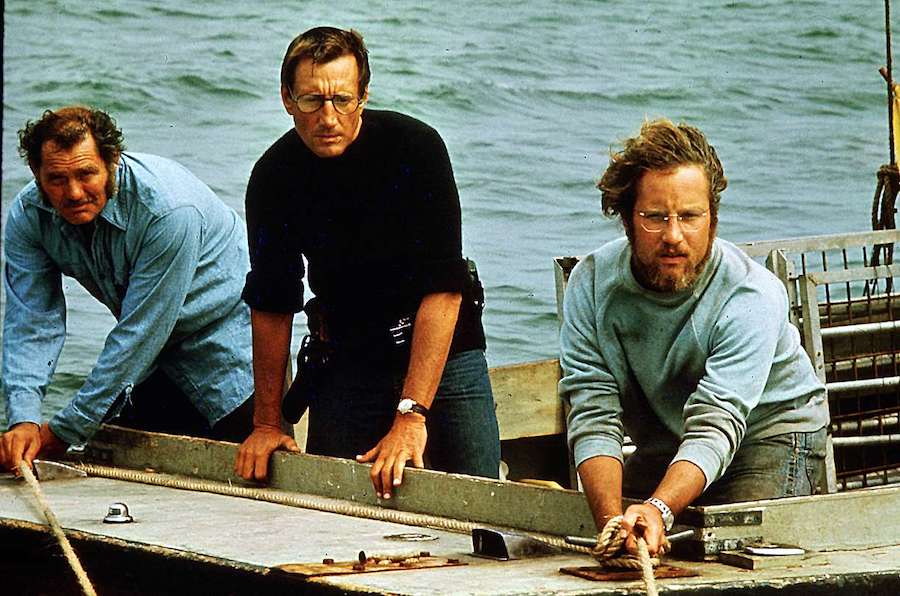
THE TERRIFYING MOTION PICTURE FROM THE TERRIFYING NO. 1 BEST SELLER.

In 1975, scientists knew a thing or two about sharks. The public, however, seemed to be largely ignorant. That must be the reason why so many believed in the horrific scenario that was presented in Steven Spielberg’s first masterpiece. There had been shark attacks… so was it entirely inconceivable that those animals might attack boats and go after humans out of vengeance? It was truly a testament to Spielberg’s abilities that Jaws became a phenomenon, one of the first true summer blockbusters to scare people out of the water and into the movie houses.
Preparing for the Fourth of July celebrations
Jaws was based on a piece of pulp fiction by Peter Benchley who knew nothing about the behavior of sharks. The screenwriters cut out the novel’s sex, focused on the action and changed a lame, ineffective ending into a much more explosive one. The film is (lovingly, I should add) set in the small fictional town of Amity, near Long Island. When a girl is killed by a shark during a late-night swim, the incident brings unexpected consequences. Amity is busy preparing for the Fourth of July celebrations and the town depends on tourist dollars. When the mayor (Murray Hamilton) hears about the attack he successfully pressures the coroner into saying that maybe it was all just a boating accident. Chief of Police Martin Brody (Roy Scheider) is skeptical, but agrees not to close the beaches.
Then disaster strikes again when a boy is virtually eaten alive before everyone’s eyes. The beaches are closed and a gruff fisherman, Quint (Robert Shaw), promises to find and kill the shark. As panic is mounting in the small town for several reasons, Quint prepares to set out on his mission aboard the Orca, together with Brody and oceanographer Matt Hooper (Richard Dreyfuss).
Fearing something we can only imagine
It takes time before the monster appears, a technique that was to be employed in many subsequent films. Because we’re so good at conjuring gruesome images in our heads, it is easy to fear something we can only imagine. The most effective sequence, one of the best Spielberg has ever made, is the one involving two drunk men, a piece of meat and a wooden pier. The way John Williams’s frightening music is employed makes it incredibly tense… and we never even see the shark. This may be a good thing, because the mechanical fish who appears in the final sequences is not as convincing as our memory would have it.
The second half of the film takes place entirely on the Orca and is a fascinating survival saga. The three men are all beautifully portrayed by the actors; Scheider as the island cop who’s afraid of water; Shaw as the WWII veteran who has dedicated his post-naval life to hunting sharks; and Dreyfuss in one of his earliest parts as the wealthy shark expert looking for an adventure (he brings a well-needed sense of humor to the crew).
A perfect example of how you create a character-building pause between scenes of terror
There’s a remarkable sequence on the boat where the men drink, show each other their scars, and sing and talk about the sinking of the USS Indianapolis. An unusual thing to see in a thriller of this kind, a perfect example of how you create a character-building pause between scenes of terror.
Benchley came to regret his depiction of sharks and subsequently worked hard to increase our understanding of the much-hunted animals. As for Spielberg and everyone else involved with the film, they should be proud. Every summer all kinds of pretenders try to create a new Jaws, but it’s like going after a white whale. This film can’t be touched.
Jaws 1975-U.S. 124 min. Color. Widescreen. Directed by Steven Spielberg. Screenplay: Peter Benchley, Carl Gottlieb. Novel: Peter Benchley. Cinematography: Bill Butler. Music: John Williams. Editing: Verna Fields. Cast: Roy Scheider (Martin Brody), Robert Shaw (Quint), Richard Dreyfuss (Matt Hooper), Lorraine Gary, Murray Hamilton, Jeffrey Kramer. Cameo: Peter Benchley.
Trivia: John Sturges was first considered for directing duties. Charlton Heston and Robert Duvall were considered for the part of Brody; Lee Marvin and Sterling Hayden for Quint; Jeff Bridges and Jon Voight for Hooper. Quint’s Indianapolis story was labored over by John Milius, Shaw and playwright Howard Sackler. The real shark footage was shot by Ron and Valerie Harper. Followed by three sequels, starting with Jaws 2 (1978).
Oscars: Best Original Score, Editing, Sound. BAFTA: Best Film Music. Golden Globe: Best Original Score.
Quote: “Martin, it’s all psychological. You yell barracuda, everybody says, ‘Huh? What?’ You yell shark, we’ve got a panic on our hands on the Fourth of July.” (Hamilton to Scheider)
Last word: “I was naive about the ocean, basically. I was pretty naive about mother nature and the hubris of a filmmaker who thinks he can conquer the elements was foolhardy, but I was too young to know I was being foolhardy when I demanded that we shoot the film in the Atlantic Ocean and not in a North Hollywood tank. But had I to do it all over again I would have gone back to the sea because it was the only way for the audience to feel that these three men were cast adrift with a great white shark hunting them.” (Spielberg, Ain’t It Cool)
